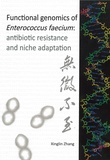Functional genomics of Enterococcus faecium
Antibiotic resistance and niche adaptation
Summary
The Gram-positive bacterium Enterococcus faecium has long been perceived as a harmlessmember of the mammalian gut microbiota. However, in the past two decades it has rapidly emerged as one of the leading causes of multidrug resistant hospital acquired infections all over the world. Many studies have been performed on the molecular epidemiology and population structure of E. faecium. These have revealed the existence of evolutionarily separate hospital-associated lineages. Comparative genomic analyses showed that hospital-acquired E. faecium isolates were genetically distinct from indigenous intestinal isolates. Although the knowledge generated from epidemiological studies and genome sequence analyses has been increasing rapidly in recent years, the functional characterization of genetic determinants of E. faecium that contribute to its success as both a gut commensal and a nosocomial pathogen is still in its infancy and have long been hampered by the lack of appropriate genetic tools. As part of the studies described in this thesis, we have developed powerful molecular tools and techniquesthat allow efficient genetic manipulation of E. faecium. This has facilitated functional genomics-based studies to systemically identify and characterize genetic determinants of antibiotic resistance and niche adaptation that are responsible for the ecological success of this nosocomial pathogen. The molecular tools that were developed in the course of this research, were used to identify genes that contribute to ampicillin resistance in E. faecium. We used a similar approach to identify genes that contribute to the resistance of E. faecium to bile salts as this trait is important for its ability to colonize the mammalian intestinal tract. Comparative genome sequence analysis led to the identification of a genetic determinant that is specifically enriched in clinical E. faecium isolates and which contributes to intestinal colonization in clinical E. faecium strains. We also identified an important adaptation in commensal E. faecium strains that is very rare in clinical isolates. Commensal strains can carry transferable megaplasmid that contains a genetic element which allows E. faecium to utilize the non-digestible sugar raffinose. Finally, the identification and transcriptional analysis of genetic determinants involved in maltodextrin utilization of E. faecium is described. In conclusion, this thesis describes the development and implementation of new molecular tools for both genome-wide and targeted genetic analyses in E. faecium. These tools provide a platform for functional genomic-based studies and allowed studies into the biology of this increasingly important nosocomial pathogen. The identified determinants may contribute importantly to the ecological success of E. faecium both as a human commensal bacterium and as an emerging nosocomial pathogen. The knowledge generated by this study may be applied for development of therapeutic strategies against gut colonization and infection by E. faecium.
